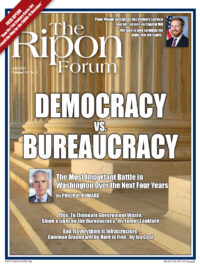
At a time when President Joe Biden is trying to cobble together a coalition of Republicans and Democrats to support a plan to invest in America’s aging infrastructure, it is worth noting how one of his predecessors did just that more than six decades earlier.
President Dwight D. Eisenhower was the driving force behind what would become not only the largest public works project ever constructed in the United States, but a project that would ultimately bear his name — The Dwight D. Eisenhower National System of Interstate and Defense Highways (EIHS).
In the two decades preceding the EIHS, there was no consensus about how to fund — much less construct — a national highway system. The lack of consensus was in part the result of the federal government’s failure to present a plan that was agreeable to both the private and public sectors. Beyond that, state governments also wanted primary control of roadbuilding and maintenance.
Eisenhower was the driving force behind what would become not only the largest public works project ever constructed in the United States, but a project that would ultimately bear his name.
To help break the deadlock, Eisenhower created a blue-ribbon committee comprised of leaders representing both private industry and organized labor. Formally called the President’s Advisory Committee on a National Highway Program, the panel was led by retired General Lucius D. Clay. The son of a Georgia Senator and West Point-trained engineer, Clay was a renowned troubleshooter and respected figure on Capitol Hill because of his efforts heading up New Deal public works projects and defense projects at the start of World War II.
Over a period of a few months in 1954, the Clay Committee, as it became informally known, concluded America’s system of roadways and bridges was outdated, obsolete, and unable to keep up with expected societal and economic growth. They developed a plan to invest in and modernize the nation’s infrastructure. President Eisenhower formally presented the Clay Committee’s report to Congress in February of 1955. The report included a letter from the President himself, which stated in part:
“Our unity as a nation is sustained by free communication of thought and by easy transportation of people and goods. The ceaseless flow of information throughout the Republic is matched by individual and commercial movement over a vast system of interconnected highways crisscrossing the country and joining at our national borders with friendly neighbors to the north and south.
“Together, the united forces of our communication and transportation systems are dynamic elements in the very name we bear — United States. Without them, we would be a mere alliance of many separate parts.”
Despite public support, the plan was met with criticism from both political parties, mostly having to do with financing. Clay remained steadfast and shifted emphasis to the importance of a standardized highway system to national security. While the plan was ultimately defeated, it did lay the groundwork for what was to come.
In his State of the Union Address the following January, President Eisenhower renewed his push for an interstate highway system. Both houses of Congress were controlled by the Democrats, but Ike’s dream remained popular throughout the country, and his administration redoubled their efforts to win bipartisan support on Capitol Hill. Once again, the biggest obstacle was financing the project. The debate over whether to issue bonds or raise taxes remained especially contentious. Ultimately, a special trust fund was created to fund surface transportation with a fuel tax. With the financing mechanism worked out, the Senate passed the final version of the bill by an overwhelming vote of 89-1 and the House quickly followed suit, approving the bill by a voice vote on the same day. Eisenhower signed the measure into law three days later.
Unfortunately, this great feat of engineering — perhaps, worthy enough to be a Wonder of the World — is now in a state of disrepair.
Today, the highway system has about 48,000 miles of roads, 10 transcontinental routes, 70 primary interstate highways, 590,000 highway bridges, countless supporting infrastructure, and an annual budget of $20 billion. Unfortunately, this great feat of engineering — perhaps, worthy enough to be a Wonder of the World — is now in a state of disrepair. Earlier this year, the American Society of Civil Engineers issued its annual report on the nation’s infrastructure, giving it a C-. Among other things, the report found that 42% of the 617,000 bridges in the U.S. are more than 50 years old, and more than 46,000 of them are rated as structurally deficient.
This bleak report was accentuated by the recent emergency closure of the Hernando de Soto Bridge, which was built in 1973 and spans the Mississippi River between West Memphis, Arkansas and Memphis, Tennessee. The bridge was hastily closed last month when a major crack was discovered in a tie girder. The closure resulted in an estimated $70 million in losses for the trucking industry, and a major inconvenience for motorists who use the bridge as a main artery. The bridge reopened with a temporary repair. But like so many other parts of our nation’s infrastructure, its future remains uncertain with an agreement on Capitol Hill in doubt.
It took presidential leadership to bring all interested parties together to build the national highway system in the 1950s, and it will take presidential leadership to bring all parties together to rebuild and modernize this system today. Fortunately, in Dwight Eisenhower, Joe Biden has the perfect example to follow in that regard.
U.S. Army Lt. Col. (Ret.), Lee Lacy is a teacher and historian in Kansas City, Mo. The views expressed in this article are those of the author and do not reflect any official organization.




